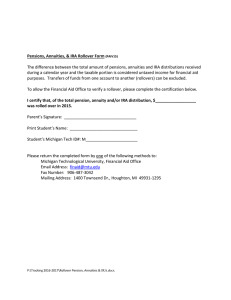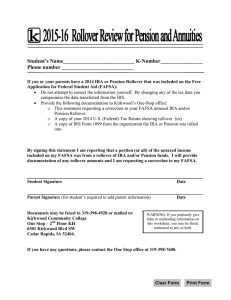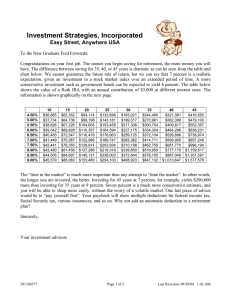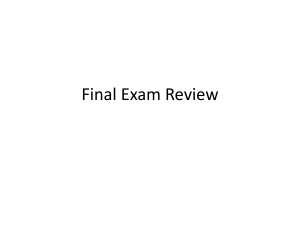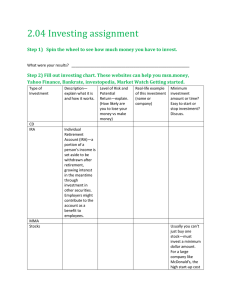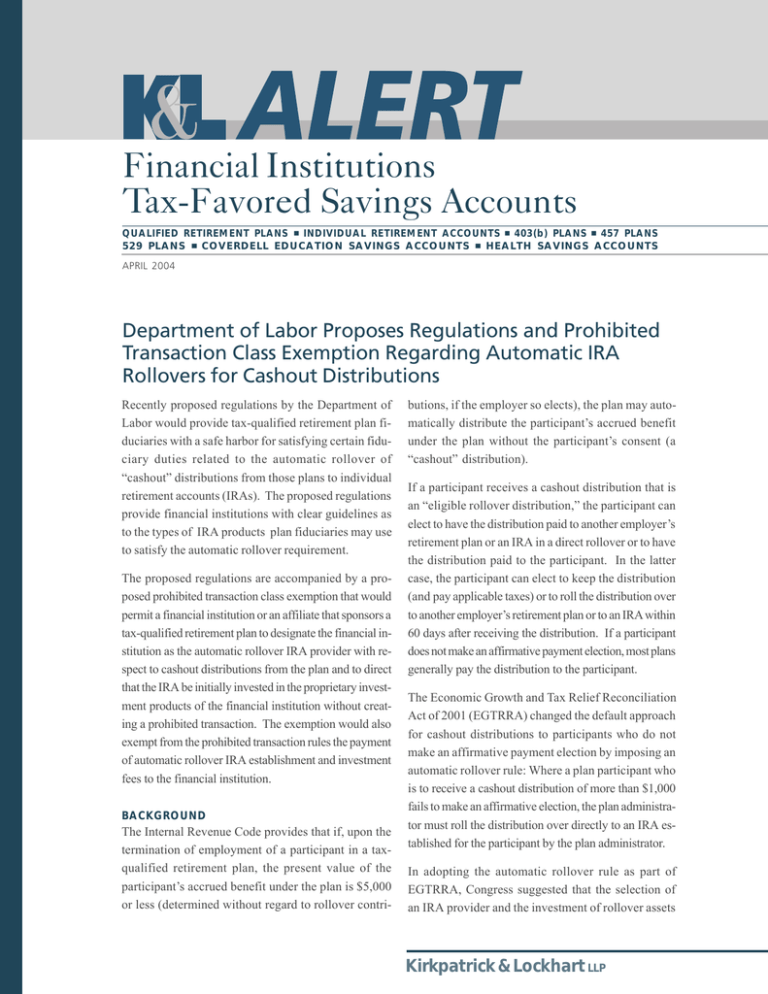
Financial Institutions
Tax-Favored Savings Accounts
QUALIFIED RETIREMENT PLANS ■ INDIVIDUAL RETIREMENT ACCOUNTS ■ 403(b) PLANS ■ 457 PLANS
529 PLANS ■ COVERDELL EDUCATION SAVINGS ACCOUNTS ■ HEALTH SAVINGS ACCOUNTS
APRIL 2004
Department of Labor Proposes Regulations and Prohibited
Transaction Class Exemption Regarding Automatic IRA
Rollovers for Cashout Distributions
Recently proposed regulations by the Department of
Labor would provide tax-qualified retirement plan fiduciaries with a safe harbor for satisfying certain fiduciary duties related to the automatic rollover of
“cashout” distributions from those plans to individual
retirement accounts (IRAs). The proposed regulations
provide financial institutions with clear guidelines as
to the types of IRA products plan fiduciaries may use
to satisfy the automatic rollover requirement.
The proposed regulations are accompanied by a proposed prohibited transaction class exemption that would
permit a financial institution or an affiliate that sponsors a
tax-qualified retirement plan to designate the financial institution as the automatic rollover IRA provider with respect to cashout distributions from the plan and to direct
that the IRA be initially invested in the proprietary investment products of the financial institution without creating a prohibited transaction. The exemption would also
exempt from the prohibited transaction rules the payment
of automatic rollover IRA establishment and investment
fees to the financial institution.
BACKGROUND
The Internal Revenue Code provides that if, upon the
termination of employment of a participant in a taxqualified retirement plan, the present value of the
participant’s accrued benefit under the plan is $5,000
or less (determined without regard to rollover contri-
butions, if the employer so elects), the plan may automatically distribute the participant’s accrued benefit
under the plan without the participant’s consent (a
“cashout” distribution).
If a participant receives a cashout distribution that is
an “eligible rollover distribution,” the participant can
elect to have the distribution paid to another employer’s
retirement plan or an IRA in a direct rollover or to have
the distribution paid to the participant. In the latter
case, the participant can elect to keep the distribution
(and pay applicable taxes) or to roll the distribution over
to another employer’s retirement plan or to an IRA within
60 days after receiving the distribution. If a participant
does not make an affirmative payment election, most plans
generally pay the distribution to the participant.
The Economic Growth and Tax Relief Reconciliation
Act of 2001 (EGTRRA) changed the default approach
for cashout distributions to participants who do not
make an affirmative payment election by imposing an
automatic rollover rule: Where a plan participant who
is to receive a cashout distribution of more than $1,000
fails to make an affirmative election, the plan administrator must roll the distribution over directly to an IRA established for the participant by the plan administrator.
In adopting the automatic rollover rule as part of
EGTRRA, Congress suggested that the selection of
an IRA provider and the investment of rollover assets
Kirkpatrick & Lockhart LLP
under an IRA in connection with automatic rollovers of
cashout distributions may be fiduciary activities under
the Employee Retirement Income Security Act of 1974, as
amended (ERISA). Thus, Congress suggested that a fiduciary charged with the tasks of selecting an automatic
rollover IRA and selecting the investments of the IRA in
general may have an obligation under ERISA to make
selections in the best interests of plan participants, prudently and in accordance with the plan documents.
Because of the potential fiduciary consequences of
the new automatic rollover rule, EGTRRA did not make
the rule immediately effective. Rather, the rule will not
become effective until the Department of Labor adopts
regulations that provide plan fiduciaries with a fiduciary “safe harbor”—a set of guidelines that, if followed, would insulate plan fiduciaries from claims of
breach of fiduciary duty regarding the selection of automatic rollover IRA providers and the investment of
assets under the IRA.
The proposed regulations set forth the requirements of
the fiduciary safe harbor required by EGTRRA. The
final regulations will become effective six months after
their adoption by the Department of Labor, at which
time the automatic rollover rule will become effective.
SAFE HARBOR REQUIREMENTS
Under the proposed regulations, the fiduciary responsible for selecting an automatic rollover IRA provider
and for investing automatic rollover IRA assets will be
deemed to have satisfied his or her fiduciary duties
under ERISA with respect to those activities if the following six requirements are met:
(1) Rollover Amount.
The amount rolled over to the IRA must not exceed the
amount that can be distributed without the participant’s
consent (i.e., $5,000 plus amounts attributable to
rollover contributions). Because the safe harbor only
applies to cashout distributions that are required to be
automatically rolled over in the absence of a plan
participant’s affirmative election to receive a distribution, the safe harbor does not apply to cashout distributions totaling $1,000 or less.
(2) IRA.
The rollover must be made to an individual retirement
account or an individual retirement annuity.
2
(3) Investments.
The rollover amount must be invested in “an investment product designed to preserve principal and provide a reasonable rate of return, whether or not such
return is guaranteed, consistent with liquidity and taking into account [permissible fees and expenses].” The
investment product must be offered by a bank or savings association, the deposits of which are insured by
the Federal Deposit Insurance Corporation; a credit
union, the member accounts of which are insured under the Federal Credit Union Act; an insurance company, the products of which are protected by state guarantee associations; or an investment company registered under the Investment Company Act of 1940. The
investment product must seek to maintain a stable dollar value equal to the amount invested in the product
by the IRA.
According to the Department of Labor, examples of
investments typically meeting these standards include
money market funds maintained by registered investment companies, interest-bearing savings accounts and
certificates of deposit offered by a bank or a similar
financial institution and other “stable value products.”
(4) Fees and Expenses.
The IRA provider may not charge fees and expenses
for an automatic rollover IRA that exceed the fees and
expenses that the IRA provider charges for other comparable IRAs that are not automatic rollover IRAs. In
addition, with the exception of charges assessed for
the establishment of the IRA, fees and expenses may
be paid only to the extent of IRA income. This latter
rule appears to be designed to prohibit fees and expenses (other than “establishment” fees) from eroding
the principal amount of the rollover.
(5) Disclosure.
The plan administrator must provide to plan participants, as part of the summary plan description or in a
summary of material modifications, a description of the
plan’s automatic rollover provisions. The description
must include (i) an explanation that the rollover will be
invested in an investment product designed to preserve principal and provide a reasonable rate of return
and liquidity, (ii) a statement indicating how the IRA’s
fees and expenses will be allocated, and (iii) the name,
address and phone number of a plan contact for further
KIRKPATRICK & LOCKHART LLP FINANCIAL INSTITUTIONS TAX-FAVORED ACCOUNTS ALERT
information concerning the plan’s automatic rollover
provisions, the IRA provider and the fees and expenses
attendant to the IRA.
(6) No Prohibited Transactions.
The plan administrator’s selection of an IRA provider
and the investment of rollover funds must not result in
a nonexempt prohibited transaction. The selection of
an IRA provider might result in two distinct prohibited
transactions, namely provision of services from a party
in interest and selection of the fiduciary or an affiliate
to provide the IRAs. Plan sponsors that are not financial institutions would engage in a prohibited transaction if they selected a third party that was a party-ininterest to provide the IRAs and related services. The
Department of Labor is of the view that those transactions would be exempt by ERISA Section 408(b)(2),
which permits parties in interest to provide services
under a reasonable contract for no more than reasonable compensation. (See 29 C.F.R. § 2550.408b-2.) However, in the Department of Labor’s view, financial institutions that select themselves (or an affiliate) as IRA
providers violate Section 406(b) of ERISA, and no current exemption is applicable.
In order to permit such institutions to provide IRAs
under these circumstances, the Department of Labor
has published a proposed class exemption that permits
the rollover of a cashout distribution from a qualified
retirement plan sponsored by a financial institution (or
an affiliate) to an IRA for which the financial institution
(or an affiliate) is the trustee or custodian. The exemption permits (i) the selection of the financial institution
(or affiliate) as the IRA provider, (ii) the initial investment of the distribution in proprietary investment products of the financial institution or an affiliate and (iii)
the receipt of fees for the establishment and maintenance of the IRA and investment of the distribution.
Section 402(f) of the Internal Revenue Code—that
the participant’s cashout distribution will be automatically rolled over to an IRA provided by the financial institution and that the financial institution
may initially invest the rollover amount in the financial institution’s own proprietary investment product.
■
The financial institution must be the employer of
the employees covered by the plan from which the
cashout distribution is made. Thus, the prohibited
transaction exemption does not apply where a financial institution, acting as a fiduciary, selects itself as the IRA provider for automatic rollovers of
cashout distributions from a plan that covers employees of unrelated companies.
■
The exemption only applies to the initial investment
of the rollover. It does not apply to any subsequent
reinvestment of the IRA’s assets by the financial
institution in the financial institution’s proprietary
investment products.
■
No sales commission may be charged in connection
with the investment in the financial institution’s proprietary investment product.
■
The rate of return or the investment performance of
the investment product selected by the financial institution must be no less favorable than the rate of
return or investment performance of an identical investment that could have been made at the same
time by a comparable IRA other than an automatic
rollover IRA.
■
The IRA owner must, within a reasonable period of
time after a request is made, be permitted to transfer
his or her IRA balance to a different investment offered by the financial institution or transfer the IRA
to a different financial institution. A fee can be
charged for the transfer or reinvestment, but, like all
nonestablishment fees, those fees can only be
charged against IRA income and cannot, therefore,
erode the principal amount of the rollover.
■
The financial institution must, for a period of six
years from the date of the rollover, retain records
sufficient to demonstrate that the requirements of
the exemption have been met. During that time, the
The exemption is available only if certain conditions
(in addition to the conditions for the fiduciary safe harbor) are met. Among these conditions are:
■
The financial institution must notify plan participants—either in the plan’s summary plan description, a summary of material modifications, or as part
of the tax notice required to be distributed in connection with any eligible rollover distribution under
APRIL 2004
Kirkpatrick & Lockhart LLP
financial institution must make those records unconditionally available to the Internal Revenue Service, the Department of Labor and the IRA owner at
its customary location for examination during reasonable business hours.
■
The fees and expenses collected by the financial
institution cannot exceed reasonable compensation.
the exclusive means by which the applicable provisions
of ERISA can be satisfied; one might expect the Department of Labor to take a similar approach with respect to automatic rollover IRAs. Accordingly, an employer that intends to satisfy the fiduciary requirements
of ERISA with respect to automatic rollover IRAs on a
non-safe harbor basis should do so cautiously.
As proposed, the requirements of the fiduciary safe
harbor (and the prohibited transaction class exemption
for financial institutions automatically rolling over distributions from their own retirement plans to their own
IRAs) do not appear to require significant alterations
to most financial institutions’ regular IRA products.
Perhaps the requirement that will require the most attention is the requirement that nonestablishment fees
and expenses cannot be charged against the principal
amount of the rollover. However, most investments
eligible for the fiduciary safe harbor should be able to
satisfy this requirement.
Finally, it is worth noting that the fiduciary safe harbor
is just that—a safe harbor. It is intended to give retirement plan fiduciaries a set of guidelines that will ensure compliance with their fiduciary obligations under
ERISA. If a rollover IRA does not satisfy the requirements of the safe harbor, a fiduciary can still theoretically argue that its selection of an IRA provider and the
initial investment of IRA assets were consistent with
its fiduciary obligations. However, in light of the certainty that will be provided by the safe harbor, employers will likely seek to conform their automatic cashout
distributions to satisfy the safe harbor requirements.
Moreover, the Department of Labor has often treated
other purported ERISA safe harbors as setting forth
MICHAEL A. HART
mhart@kl.com
412.355.6211
Our Financial Institution Tax-Favored Savings Accounts
practice is part of our Employee Benefit Plans/ERISA
practice. If you would like more information about our
Employee Benefit Plans/ERISA practice, please contact
one of the attorneys listed below:
Boston
Stephen E. Moore
617.951.9191
smoore@kl.com
Los Angeles
William P. Wade
310.552.5071
wwade@kl.com
New York
David E. Morse
212.536.3998
dmorse@kl.com
Pittsburgh
William T. Cullen
Michael A. Hart
J. Richard Lauver
Charles R. Smith
Richard E. Wood
Linda B. Beckman
Sonia A. Chung
Douglas J. Ellis
412.355.8600
412.355.6211
412.355.6454
412.355.6536
412.355.8676
412.355.6528
412.355.6716
412.355.8375
wcullen@kl.com
mhart@kl.com
rlauver@kl.com
csmith@kl.com
rwood@kl.com
lbeckman@kl.com
schung@kl.com
dellis@kl.com
San Francisco
Laurence A. Goldberg
Katherine L. Aizawa
Marc R. Baluda
415.249.1043
415.249.1044
415.249.1036
lgoldberg@kl.com
kaizawa@kl.com
mbaluda@kl.com
Wa s h i n g t o n
Catherine S. Bardsley
William A. Schmidt
David Pickle
Lori G. Galletto
202.778.9289
202.778.9373
202.778.9887
202.778.9024
cbardsley@kl.com
william.schmidt@kl.com
dpickle@kl.com
lgalletto@kl.com
®
Kirkpatrick & Lockhart LLP
Challenge us. ®
www.kl.com
BOSTON
■
DALLAS
■
HARRISBURG
■
LOS ANGELES
■
MIAMI
■
NEWARK
■
NEW YORK
■
PITTSBURGH
■
SAN FRANCISCO
■
WASHINGTON
...............................................................................................................................................................
This publication/newsletter is for informational purposes and does not contain or convey legal advice. The information herein
should not be used or relied upon in regard to any particular facts or circumstances without first consulting a lawyer.
© 2004 KIRKPATRICK & LOCKHART LLP.
ALL RIGHTS RESERVED.

